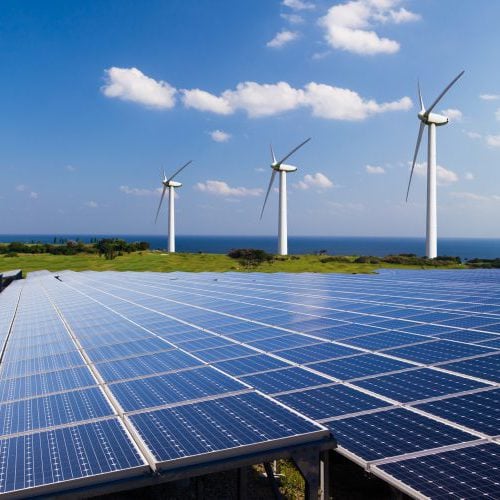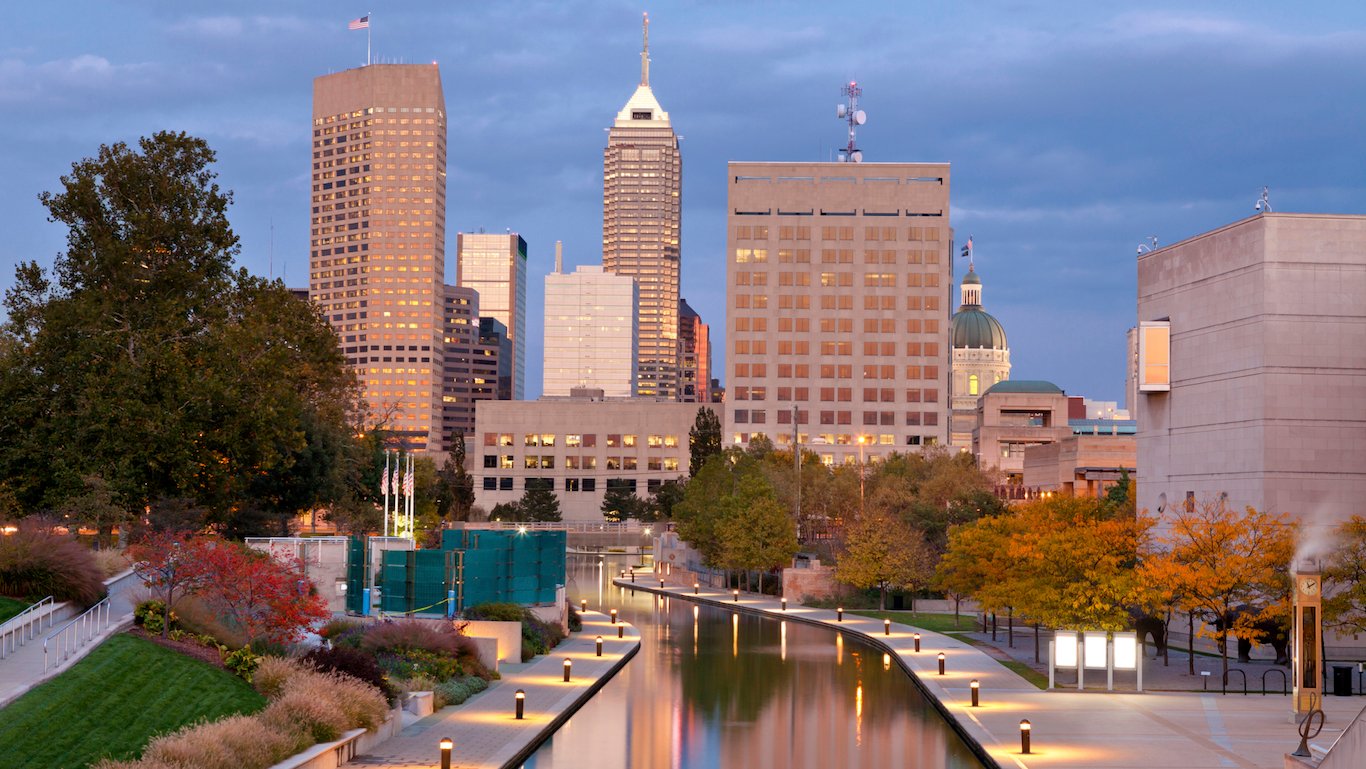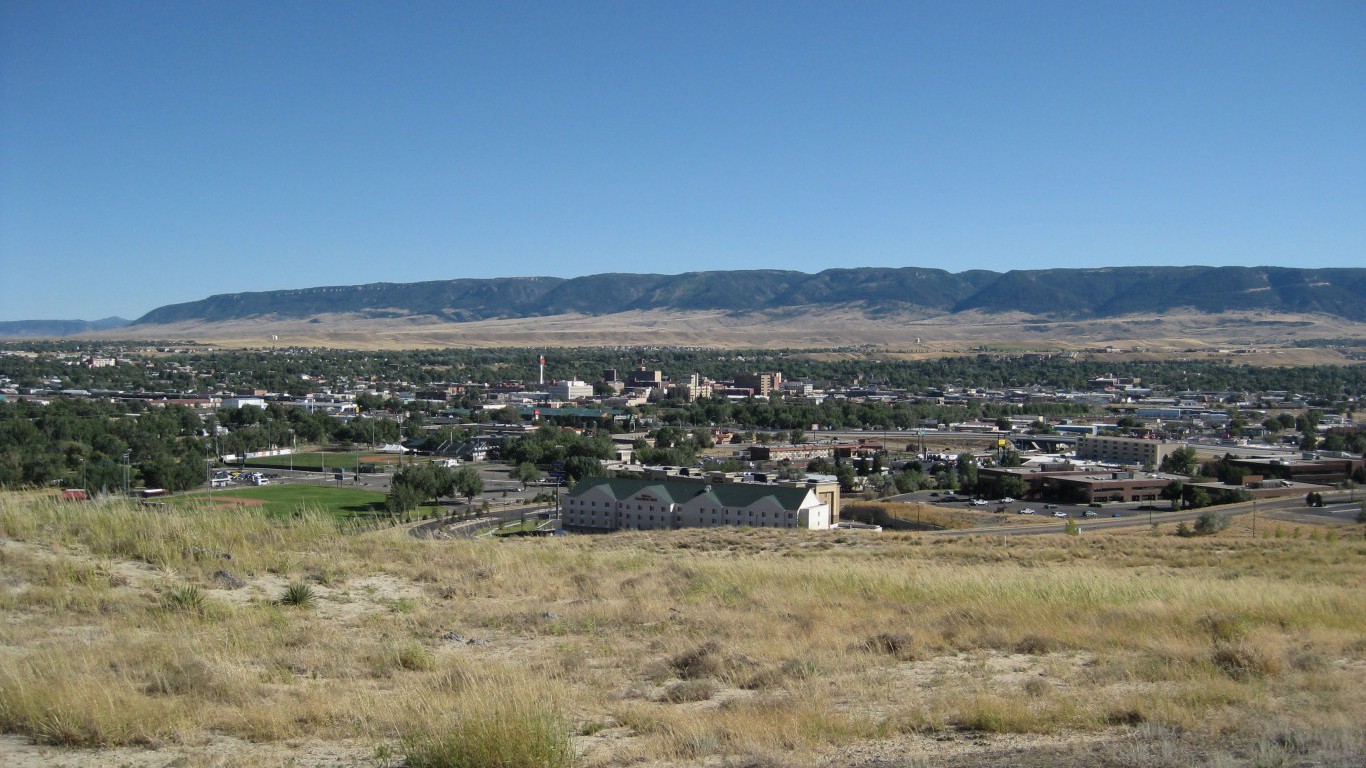Special Report
States Producing the Most Renewable Energy

Published:
Last Updated:

Climate change is widely viewed as one of the long-term events most threatening to the Earth and human life. Research shows that since the Industrial Revolution in the 1700s, changes in the Earth’s climate are due in part to human activity — specifically, the burning of fossil fuels and the emission of greenhouse gas.
Fossil fuels have another drawback, in addition to their contribution to climate change: they are finite energy sources. Sooner or later, renewable fuel sources will be needed to sustain the current trajectory of global energy consumption. Renewables continue to be chosen by businesses and individuals over conventional sources.
While U.S. crude oil and natural gas production fell last year, energy production from renewable sources — geothermal, hydro, solar, biomass, wind, wood, and wood-derived fuels
— increased significantly. Current renewable energy production varies widely by geography. For reference, 13.3% of electricity generated nationwide comes from renewable sources.
Click here to see the states producing the most renewable energy.
Based on 24/7 Wall St. analysis of data from the Energy Information Administration, Vermont leads the nation with 99.8% of electricity production accounted for by renewable sources. Delaware produces the least renewable energy as a percentage of its total electricity generation, at just 1.7%.
States have plenty of renewable energy options to choose from. Hydroelectric dams are the largest renewable source in 22 states; wind turbines generate the largest share of renewable energy in 16 states.
Solar panels are a popular option for individuals, families, and small businesses. Compared to wind and hydroelectric, which must rely largely on mechanical improvements to produce more electricity, solar is often touted as having the greatest untapped potential. According to research organization Bloomberg New Energy Finance, solar will become more cost-effective than coal by 2025.
To identify the states using the most renewable energy, 24/7 Wall St. reviewed the percentage of electricity generated by renewable energy sources in each state in 2015. Renewable energy sources are defined as geothermal, conventional hydroelectric, solar, biomass, wind, and wood and wood derived fuels. All data came from the U.S. Energy Information Administration (EIA).
These are the states producing the most renewable energy.

50. Delaware
> Electricity from renewables: 1.7%
> Total electricity generation: 7,810 GWh (4th lowest)
> Largest renewable growth: Other biomass
> 10-yr. renewable energy growth: N/A
[in-text-ad]

49. Ohio
> Electricity from renewables: 2.1%
> Total electricity generation: 121,893 GWh (10th highest)
> Largest renewable growth: Wind
> 10-yr. renewable energy growth: 130.6% (13th highest)

48. New Jersey
> Electricity from renewables: 2.2%
> Total electricity generation: 74,609 GWh (22nd highest)
> Largest renewable growth: Other biomass
> 10-yr. renewable energy growth: 68.5% (21st highest)

47. Florida
> Electricity from renewables: 2.3%
> Total electricity generation: 237,413 GWh (2nd highest)
> Largest renewable growth: Other biomass
> 10-yr. renewable energy growth: 18.8% (16th lowest)
[in-text-ad-2]

46. Mississippi
> Electricity from renewables: 2.3%
> Total electricity generation: 64,758 GWh (25th highest)
> Largest renewable growth: Wood and wood derived fuels
> 10-yr. renewable energy growth: -2.2% (7th lowest)

45. Connecticut
> Electricity from renewables: 3.0%
> Total electricity generation: 37,471 GWh (15th lowest)
> Largest renewable growth: Other biomass
> 10-yr. renewable energy growth: -15.3% (3rd lowest)
[in-text-ad]

44. Missouri
> Electricity from renewables: 3.3%
> Total electricity generation: 83,640 GWh (18th highest)
> Largest renewable growth: Hydroelectric conventional
> 10-yr. renewable energy growth: 1142.9% (the highest)

43. Louisiana
> Electricity from renewables: 3.4%
> Total electricity generation: 107,812 GWh (14th highest)
> Largest renewable growth: Wood and wood derived fuels
> 10-yr. renewable energy growth: 0.8% (12th lowest)

42. Rhode Island
> Electricity from renewables: 3.4%
> Total electricity generation: 6,939 GWh (3rd lowest)
> Largest renewable growth: Other biomass
> 10-yr. renewable energy growth: 54.2% (25th highest)
[in-text-ad-2]

41. West Virginia
> Electricity from renewables: 3.8%
> Total electricity generation: 72,295 GWh (23rd highest)
> Largest renewable growth: Hydroelectric conventional
> 10-yr. renewable energy growth: 58.4% (23rd highest)

40. Pennsylvania
> Electricity from renewables: 3.9%
> Total electricity generation: 214,572 GWh (3rd highest)
> Largest renewable growth: Wind
> 10-yr. renewable energy growth: 58.4% (22nd highest)
[in-text-ad]

39. Kentucky
> Electricity from renewables: 4.6%
> Total electricity generation: 83,544 GWh (19th highest)
> Largest renewable growth: Hydroelectric conventional
> 10-yr. renewable energy growth: 26.0% (18th lowest)

38. Utah
> Electricity from renewables: 4.6%
> Total electricity generation: 41,949 GWh (18th lowest)
> Largest renewable growth: Hydroelectric conventional
> 10-yr. renewable energy growth: 103.9% (17th highest)

37. South Carolina
> Electricity from renewables: 5.0%
> Total electricity generation: 96,532 GWh (16th highest)
> Largest renewable growth: Hydroelectric conventional
> 10-yr. renewable energy growth: 30.7% (19th lowest)
[in-text-ad-2]

36. Indiana
> Electricity from renewables: 5.3%
> Total electricity generation: 104,019 GWh (15th highest)
> Largest renewable growth: Wind
> 10-yr. renewable energy growth: 674.8% (4th highest)

35. Illinois
> Electricity from renewables: 5.9%
> Total electricity generation: 193,952 GWh (5th highest)
> Largest renewable growth: Wind
> 10-yr. renewable energy growth: 1020.0% (2nd highest)
[in-text-ad]

34. Georgia
> Electricity from renewables: 6.1%
> Total electricity generation: 128,818 GWh (8th highest)
> Largest renewable growth: Wood and wood derived fuels
> 10-yr. renewable energy growth: 31.0% (20th lowest)

33. Virginia
> Electricity from renewables: 6.3%
> Total electricity generation: 84,412 GWh (17th highest)
> Largest renewable growth: Wood and wood derived fuels
> 10-yr. renewable energy growth: 39.2% (21st lowest)

32. North Carolina
> Electricity from renewables: 6.8%
> Total electricity generation: 128,388 GWh (9th highest)
> Largest renewable growth: Hydroelectric conventional
> 10-yr. renewable energy growth: 53.6% (25th lowest)
[in-text-ad-2]

31. Maryland
> Electricity from renewables: 7.4%
> Total electricity generation: 36,366 GWh (13th lowest)
> Largest renewable growth: Hydroelectric conventional
> 10-yr. renewable energy growth: -1.4% (9th lowest)

30. Michigan
> Electricity from renewables: 7.8%
> Total electricity generation: 113,008 GWh (12th highest)
> Largest renewable growth: Wind
> 10-yr. renewable energy growth: 121.6% (14th highest)
[in-text-ad]

29. Massachusetts
> Electricity from renewables: 8.3%
> Total electricity generation: 32,086 GWh (11th lowest)
> Largest renewable growth: Other biomass
> 10-yr. renewable energy growth: -4.7% (5th lowest)

28. Wisconsin
> Electricity from renewables: 8.3%
> Total electricity generation: 66,360 GWh (24th highest)
> Largest renewable growth: Hydroelectric conventional
> 10-yr. renewable energy growth: 86.9% (19th highest)

27. Alabama
> Electricity from renewables: 8.6%
> Total electricity generation: 152,477 GWh (6th highest)
> Largest renewable growth: Hydroelectric conventional
> 10-yr. renewable energy growth: 18.1% (15th lowest)
[in-text-ad-2]

26. New Mexico
> Electricity from renewables: 8.7%
> Total electricity generation: 32,701 GWh (12th lowest)
> Largest renewable growth: Wind
> 10-yr. renewable energy growth: 92.0% (18th highest)

25. Arkansas
> Electricity from renewables: 9.0%
> Total electricity generation: 55,559 GWh (22nd lowest)
> Largest renewable growth: Hydroelectric conventional
> 10-yr. renewable energy growth: 53.1% (24th lowest)
[in-text-ad]

24. Arizona
> Electricity from renewables: 9.4%
> Total electricity generation: 113,142 GWh (11th highest)
> Largest renewable growth: Hydroelectric conventional
> 10-yr. renewable energy growth: 55.9% (24th highest)

23. Wyoming
> Electricity from renewables: 9.4%
> Total electricity generation: 48,967 GWh (20th lowest)
> Largest renewable growth: Wind
> 10-yr. renewable energy growth: 188.6% (12th highest)

22. Texas
> Electricity from renewables: 10.6%
> Total electricity generation: 449,826 GWh (the highest)
> Largest renewable growth: Wind
> 10-yr. renewable energy growth: 461.7% (7th highest)
[in-text-ad-2]

21. Nebraska
> Electricity from renewables: 12.4%
> Total electricity generation: 39,883 GWh (17th lowest)
> Largest renewable growth: Wind
> 10-yr. renewable energy growth: 309.1% (9th highest)

20. Hawaii
> Electricity from renewables: 13.2%
> Total electricity generation: 10,120 GWh (6th lowest)
> Largest renewable growth: Wind
> 10-yr. renewable energy growth: 81.6% (20th highest)
[in-text-ad]

19. Tennessee
> Electricity from renewables: 14.2%
> Total electricity generation: 75,215 GWh (21st highest)
> Largest renewable growth: Hydroelectric conventional
> 10-yr. renewable energy growth: 25.1% (17th lowest)

18. New Hampshire
> Electricity from renewables: 16.6%
> Total electricity generation: 20,016 GWh (9th lowest)
> Largest renewable growth: Wood and wood derived fuels
> 10-yr. renewable energy growth: 45.8% (23rd lowest)

17. Colorado
> Electricity from renewables: 18.0%
> Total electricity generation: 52,393 GWh (21st lowest)
> Largest renewable growth: Wind
> 10-yr. renewable energy growth: 250.8% (10th highest)
[in-text-ad-2]

16. Nevada
> Electricity from renewables: 18.9%
> Total electricity generation: 39,047 GWh (16th lowest)
> Largest renewable growth: Geothermal
> 10-yr. renewable energy growth: 116.6% (15th highest)

15. Minnesota
> Electricity from renewables: 21.8%
> Total electricity generation: 56,980 GWh (24th lowest)
> Largest renewable growth: Wind
> 10-yr. renewable energy growth: 242.6% (11th highest)
[in-text-ad]

14. Oklahoma
> Electricity from renewables: 22.4%
> Total electricity generation: 76,136 GWh (20th highest)
> Largest renewable growth: Wind
> 10-yr. renewable energy growth: 546.8% (5th highest)

13. North Dakota
> Electricity from renewables: 23.2%
> Total electricity generation: 37,157 GWh (14th lowest)
> Largest renewable growth: Wind
> 10-yr. renewable energy growth: 354.2% (8th highest)

12. New York
> Electricity from renewables: 23.3%
> Total electricity generation: 138,628 GWh (7th highest)
> Largest renewable growth: Hydroelectric conventional
> 10-yr. renewable energy growth: 8.0% (13th lowest)
[in-text-ad-2]

11. Kansas
> Electricity from renewables: 24.3%
> Total electricity generation: 45,527 GWh (19th lowest)
> Largest renewable growth: Wind
> 10-yr. renewable energy growth: 1006.4% (3rd highest)

10. Alaska
> Electricity from renewables: 28.4%
> Total electricity generation: 6,285 GWh (2nd lowest)
> Largest renewable growth: Hydroelectric conventional
> 10-yr. renewable energy growth: 44.9% (22nd lowest)
[in-text-ad]

9. California
> Electricity from renewables: 30.1%
> Total electricity generation: 196,704 GWh (4th highest)
> Largest renewable growth: Solar thermal and photovoltaic
> 10-yr. renewable energy growth: -17.7% (2nd lowest)

8. Iowa
> Electricity from renewables: 33.7%
> Total electricity generation: 56,659 GWh (23rd lowest)
> Largest renewable growth: Wind
> 10-yr. renewable energy growth: 467.5% (6th highest)

7. Montana
> Electricity from renewables: 40.5%
> Total electricity generation: 29,302 GWh (10th lowest)
> Largest renewable growth: Hydroelectric conventional
> 10-yr. renewable energy growth: 11.4% (14th lowest)
[in-text-ad-2]

6. Maine
> Electricity from renewables: 66.5%
> Total electricity generation: 11,741 GWh (7th lowest)
> Largest renewable growth: Hydroelectric conventional
> 10-yr. renewable energy growth: -5.3% (4th lowest)

5. Oregon
> Electricity from renewables: 67.7%
> Total electricity generation: 57,867 GWh (25th lowest)
> Largest renewable growth: Hydroelectric conventional
> 10-yr. renewable energy growth: -1.2% (10th lowest)
[in-text-ad]

4. Idaho
> Electricity from renewables: 74.7%
> Total electricity generation: 15,667 GWh (8th lowest)
> Largest renewable growth: Hydroelectric conventional
> 10-yr. renewable energy growth: -1.9% (8th lowest)

3. Washington
> Electricity from renewables: 75.5%
> Total electricity generation: 109,287 GWh (13th highest)
> Largest renewable growth: Hydroelectric conventional
> 10-yr. renewable energy growth: -2.4% (6th lowest)

2. South Dakota
> Electricity from renewables: 76.3%
> Total electricity generation: 9,633 GWh (5th lowest)
> Largest renewable growth: Hydroelectric conventional
> 10-yr. renewable energy growth: 107.2% (16th highest)
[in-text-ad-2]

1. Vermont
> Electricity from renewables: 99.8%
> Total electricity generation: 1,982 GWh (the lowest)
> Largest renewable growth: Hydroelectric conventional
> 10-yr. renewable energy growth: 0.5% (11th lowest)
Ever wanted an extra set of eyes on an investment you’re considering? Now you can speak with up to 3 financial experts in your area for FREE. By simply
clicking here you can begin to match with financial professionals who can help guide you through the financial decisions you’re making. And the best part? The first conversation with them is free.
Click here to match with up to 3 financial pros who would be excited to help you make financial decisions.
Thank you for reading! Have some feedback for us?
Contact the 24/7 Wall St. editorial team.